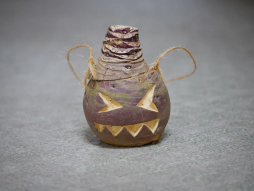Halloween. The season of costumes, pumpkin carving and candy. And let’s not forget, articles telling Christians not to let their children trick or treat because this holiday derives from cult traditions. And because cults are inherently satanic, Christians should steer clear of anything related to them.
Sarah Shectman in a Bible Odyssey article defining the word “cult” says: “When scholars are studying religion” the word refers to “a system of worship related to a specific deity.” The Latin word cultus, from which the English word “cult” is derived, means “care” or “adoration” and has no negative connotation at all.

Mallory Challis
In Leviticus, for instance, the people discussed in the text are considered an Israelite cult because the book outlines the standards for how they made sacrifices and ritually worshipped Yahweh.
This is a lot different from the way that we use the word today. We use it in a derogatory way to describe religions that we do not like, rather than in its literal sense.
So, now that we have defined “cult,” what can we say about the origins of Halloween?
The Celtic New Year’s Festival
According to Joshua Mark in an article for the World History Encyclopedia, Halloween originates from the festival of Samhain, meaning “summer’s end.” This was the Celtic New Year’s festival which “marked the close of the harvest” and the incoming winter.
The Celts believed that during this seasonal transition, “the veil between the worlds of the living and the dead were thinnest.” This was when the dead who had not yet transitioned to the afterlife would do so, and when spirits already in the afterlife were able to come back to the realm of the living.
To deceive the spirits of the dead that one may have wronged, people used the ashes from bonfires to darken their faces. Later, they began wearing masks to protect themselves from potential harm. However, they believed if the spirit of a loved one came about, they would be able to recognize them and reveal themselves while remaining safe from unwanted spirits.
All Hallows Eve
In the seventh century, Pope Boniface IV established May 13 as All Saint’s Day, or All Hallows Day, to celebrate the saints who did not have a holiday of their own. This was commemorated with a feast. However, in the eighth century, Pope Gregory III moved this holiday to Nov. 1, and although the exact reasoning for this is up for debate, some scholars think this was an attempt to Christianize the Samhain festival. This is believed to be true because of “an established Christian paradigm of ‘redeeming’ all things pagan” to encourage the population to convert to Christianity.
So, with the establishment of All Saint’s Day and its movement to Nov. 1, Samhain became known as “All Hallows Eve,” the holiday we now call Halloween.
The origin of trick or treating
Once it became a Christian tradition, All Hallows Eve was celebrated as a night of vigil, prayer and fasting in preparation for the honoring of the saints on the next day. Old traditions, such as recognizing the changing of the seasons, were still observed, but with Christian beliefs intertwined.

Soul cakes
New rituals were added as well. “Souling” was practiced by the poor, in which they “would go about knocking on doors asking for soul-cake” in exchange for prayer.
Scholars believe that this practice began because of the Catholic belief in purgatory, which is a place or state of additional spiritual cleansing where a sinner’s soul lingers before being sent to heaven or hell. By some Catholic beliefs, when a soul is in purgatory, it remains in torment unless the living elevate it in prayer, so the practice of souling was primarily religious in origin. Offering soul-cakes on All Hallows Eve ensured that extra people were praying for your dead loved ones, giving them a better chance of escaping purgatory.
Jack-o’-lanterns originated a bit later when Halloween made its way into North America. The Irish Catholics in the United States combined folk tradition with the religious history of the holiday.

Turnip jack-o-lantern
The Irish folk tale “Stingy Jack” told of a “clever and drunk con man who fooled the devil into banning him from hell.” However, because he lived such a sinful life, Jack was not able to enter heaven either. So, once he died, he was forced to roam the earth carrying a “small lantern made of turnip with a red-hot ember from hell inside to light his way.”
As Irish Catholics continued to celebrate the holiday, they began making their own lanterns out of hollowed-out turnips with faces carved on the sides. When they went out souling, they would place lit candles inside and carry them around to protect themselves from spirits like Stingy Jack, as they still believed that during this time, the veil between the living and the dead was thinnest.
And it is with these traditions that Halloween as we know it originated. From bonfire ashes and masks to soul-cakes in exchange for prayer and hollowed-out turnips, the history of Halloween is one full of religious tradition. In fact, Halloween is a Christianized version of a Celtic harvest festival. So, think twice the next time you see an article saying that Halloween is a cultic holiday that should not be celebrated by Christians– the history tells a different story.
Mallory Challis is a senior at Wingate University and serves this semester as BNG’s Clemons Fellow.
Related articles:
Thoughts on Halloween, saints and souls | Opinion by David Gushee
Seven Reasons Why Christians Should Celebrate Halloween | Opinion by Alan Rudnick


